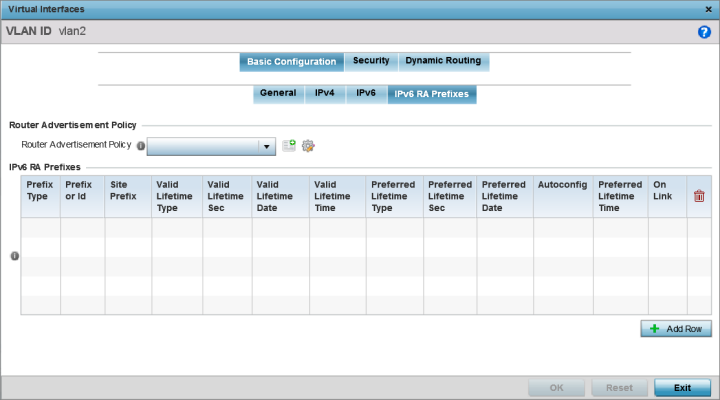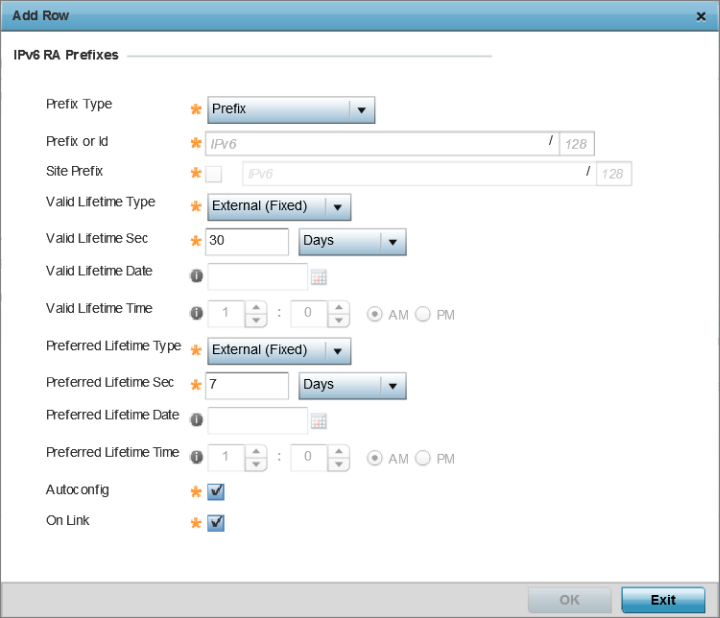OSPF IPv6 RA Prefixes
About this task
To set the VLAN IPv6 RA Prefixes:
Procedure
-
Select the IPv6 RA Prefixes
tab.
The IPv6 RA Prefix configuration screen displays.
 OSPF - VLAN Interface IPv6 RA Prefix Configuration Screen
OSPF - VLAN Interface IPv6 RA Prefix Configuration Screen
-
Use the Router Advertisement
Policy drop-down menu to select and apply a policy to the virtual
interface.
Router advertisements are periodically sent to hosts or sent in response to solicitation requests. The advertisement includes IPv6 prefixes and other subnet and host information. For more information on Router Advertisement Policy, see IPv6 Router Advertisment Policy.
-
Review the configurations of
existing IPv6 advertisement policies. If needed select + Add Row to
define the configuration of an additional IPv6 RA prefix.
The add/edit IPv6 RA Prefixes configuration screen displays.
 Add/Edit IPv6 RA Prefixes Configuration Screen
Add/Edit IPv6 RA Prefixes Configuration Screen
-
Set the following IPv6 RA Prefixes
settings:
Prefix Type
Set the prefix delegation type used with this configuration. Options include, Prefix, and prefix-from-provider. The default setting is Prefix. A prefix allows an administrator to associate a user defined name to an IPv6 prefix. A provider assigned prefix is made available from an ISP (Internet Service Provider) to automate the process of providing and informing the prefixes used.
Prefix or ID
Set the actual prefix or ID used with the IPv6 router advertisement.
Site Prefix
The site prefix is added into a router advertisement prefix. The site address prefix signifies the address is only on the local link.
Valid Lifetime Type
Set the lifetime for the prefix's validity. Options include External (fixed), decrementing and infinite. If set to External (fixed), just the Valid Lifetime Sec setting is enabled to define the exact time interval for prefix validity. If set to decrementing, use the lifetime date and time settings to refine the prefix expiry period. If the value is set for infinite, no additional date or time settings are required for the prefix and the prefix will not expire. The default setting is External (fixed).
Valid Lifetime Sec
If the lifetime type is set to External (fixed), set the Seconds, Minutes, Hours or Days value used to measurement criteria for the prefix's expiration. 30 days, 0 hours, 0 minutes and 0 seconds is the default lifetime.
Valid Lifetime Date
If the lifetime type is set to decrementing, set the date in MM/DD/YYYY format for the expiration of the prefix.
Valid Lifetime Time
If the lifetime type is set to decrementing, set the time for the prefix's validity. Use the spinner controls to set the time in hours and minutes. Use the AM PM radio buttons to set the appropriate hour.
Preferred Lifetime Type
Set the administrator preferred lifetime for the prefix's validity. Options include External (fixed), decrementing and infinite. If set to External (fixed), just the Valid Lifetime Sec setting is enabled to define the exact time interval for prefix validity. If set to decrementing, use the lifetime date and time settings to refine the prefix expiry period. If the value is set for infinite, no additional date or time settings are required for the prefix and the prefix will not expire. The default setting is External (fixed).
Preferred Lifetime Sec
If the administrator preferred lifetime type is set to External (fixed), set the Seconds, Minutes, Hours or Days value used to measure criteria for the prefix's expiration. 30 days, 0 hours, 0 minutes and 0 seconds is the default lifetime.
Preferred Lifetime Date
If the administrator preferred lifetime type is set to decrementing, set the date in MM/DD/YYYY format for the expiration of the prefix.
Preferred Lifetime Time
If the preferred lifetime type is set to decrementing, set the time for the prefix's validity. Use the spinner controls to set the time in hours and minutes. Use the AM PM radio buttons to set the appropriate hour.
Autoconfig
Autoconfiguration includes generating a link-local address, global addresses via stateless address autoconfiguration and duplicate address detection to verify the uniqueness of the addresses on a link. This setting is enabled by default.
On Link
Select this option to keep the IPv6 RA prefix on the local link. The default setting is enabled.
-
Click OK to save the
IPv6 RA prefix configuration changes.
Click Exit to close the screen without saving the updates.


